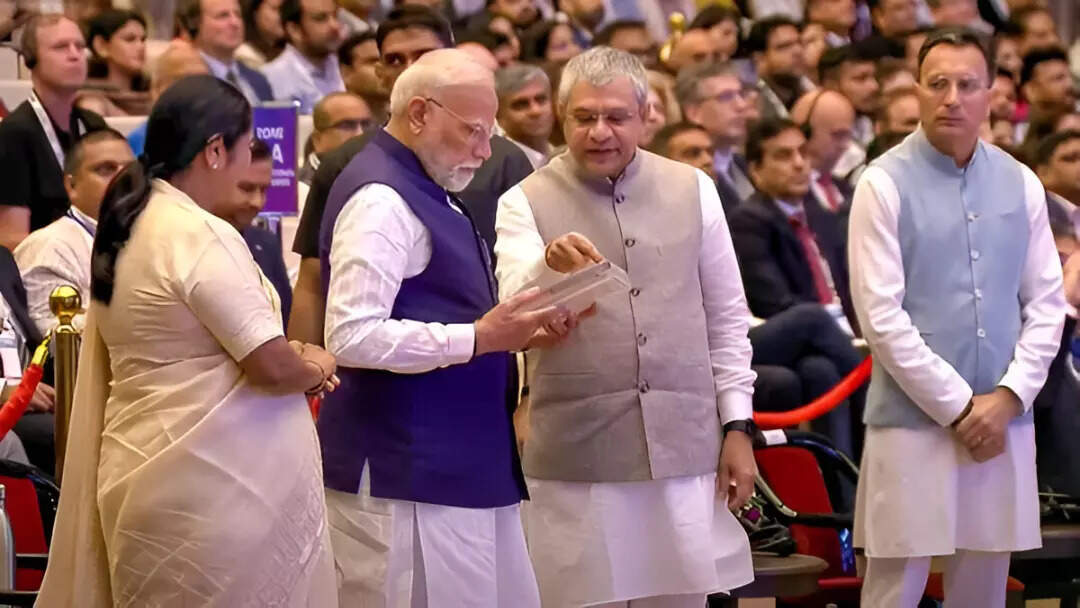
Union Minister for Electronics and Information Technology Ashwini Vaishnaw on Tuesday presented India’s first indigenously developed chip to Prime Minister Narendra Modi at the inauguration of Semicon India 2025 in Delhi, reports ANI.
Vaishnaw handed over the Vikram 32-bit processor, developed by ISRO’s Semiconductor Lab, along with test chips from four approved projects. The Vikram microprocessor has already been qualified for use in launch vehicle conditions, making it a milestone in India’s chip-making journey.
“Just a few years ago, we met for the first time to make a new beginning driven by our Prime Minister’s vision, we launched the India Semiconductor Mission. In a short span of 3.5 years, we have the world looking at India with confidence. Today, the construction of five semiconductor units is going on at a rapid pace. We just presented the first ‘Made-in-India’ chip to PM Modi,” Vaishnaw said at the event.
He framed India as a dependable partner in uncertain times. “We are living in unprecedented times, global policy turmoil has created uncertainty. In these turbulent times, India stands as a lighthouse of stability and growth. You should come to India because our policies are stable,” he added.
Government push for semiconductor ecosystem
Since the launch of the India Semiconductor Mission (ISM) in 2021, the government has announced a ₹76,000 crore Production-Linked Incentive scheme, of which nearly ₹65,000 crore has already been committed. On August 28, a pilot Outsourced Semiconductor Assembly and Test (OSAT) line was inaugurated in Sanand, Gujarat, with CG-Semi expected to roll out the first chip from the facility soon.Through the Design Linked Incentive scheme, 23 chip design projects have been sanctioned, supporting startups and innovators working across defence, aerospace, electric vehicles, and energy systems. In June 2023, the government approved the first semiconductor manufacturing proposal in Sanand. To date, 10 projects worth over ₹1.60 lakh crore have been cleared across Gujarat, Assam, Uttar Pradesh, Punjab, Odisha, and Andhra Pradesh.
India’s deep roots in global chip design
While India’s fabrication ambitions are still at an early stage, the country already plays a central role in semiconductor design. A Bastion Research report noted that about 20 per cent of the world’s chip design engineers are based in India, underlining its weight in the global semiconductor ecosystem.Global players such as Qualcomm, Intel, Nvidia, Broadcom, and MediaTek have large R&D and design centres in Bengaluru, Hyderabad, and Noida, enabling India to emerge as one of the world’s leading chip design hubs.
The report also explained the global division of labour: US engineers largely decide the “what” and “why” of chip development — defining the architecture, product strategy, and market positioning — while Indian teams focus on the “how,” taking these ideas to execution.
It added that engineers in India translate architectures into logic, simulate and test designs, optimise performance and power, write drivers and firmware, and support key electronic design automation tools.
Far from being a top-down relationship, the report clarified, this partnership works because of India’s scale and precision in execution, complementing US strengths in product definition.
Semicon India 2025
The three-day Semicon India 2025 conference is designed to spotlight this strength while also pushing the next frontier — fabrication. Covering chip design, fabrication, and packaging, the event aims to position India not just as a design powerhouse but as a full-stack semiconductor hub.
With its vast pool of engineers, proven design capabilities, and a government eager to roll out incentives, India is steadily carving a place for itself in the global semiconductor value chain.

